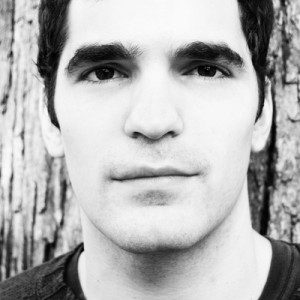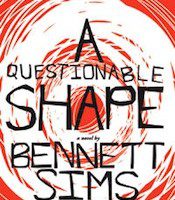“What we know about the undead so far is this: they return to the familiar.” Thus begins Bennett Sims’ debut novel A Questionable Shape. The subject matter of this brilliantly sensitive, whip-smart new novel is at first glance almost overbearingly familiar. The book is, at its most basic level, a zombie book; you could even call it a zombie mystery novel: Michael Vermaelen accompanies his best friend Mazoch as Mazoch attempts to find his zombie father before hurricane season hits Baton Rouge.
But, the zombies in this text, unlike most of the undead I’ve encountered in popular culture, don’t just run around searching out brains to slurp up, they are in fact quite sentimental. They “wander to nostalgically charged sites from their former lives,” due to some instinct that is activated within them, an instinct akin to that of the homing pigeons who are “famous and fascinating for the particles of magnetite in their skulls: bits of mineral sensitive to the electromagnetic pulls and capable of directing [them], like the needle of a compass, homeward over vast and alien distances.” However, even this unique trait is, as Sims’ narrator points out, not entirely unfamiliar. It finds its echo in the words of, among others, Thomas Hardy (“My spirit will not haunt the mound/ Above my breast/ But travel, memory-possessed/ To where my tremulous being found/ Life largest, best.”) Sims’ genius lies in how he builds a terrifically engrossing and utterly unique novel, not in spite, but rather because of the familiarity of the material. His characters are themselves hyper-aware that what has befallen them is in effect a campy horror flick come to life. Sims plays with our collective knowledge of the undead, interweaving his zombies’ penchant for the familiar with our own familiarity with the subject and his narrator’s internal struggle with those he is most familiar with, so that the novel becomes, among other things, an exploration of the very concept of familiarity.
In A Questionable Shape, Sims maps the nearly intangible synapses inside us, the systems of memories and associations that build throughout our lives, separating us from others who have their own unique sets of associations and at the same times cementing the relationships we build off overlapping memories and experiences. Just as an angiograph makes visible the lumen of human blood vessels, so Sims’ novel traces the circuits of perception that bring us circling back to particular places and people, those smells that will always remind us of our childhood kitchen, those shivers of déjà vu that we can’t quite pin down. Sims’ narrator, Vermaelen, obsesses over the ways in which the language of associations we share with other people can bring us instantaneously closer— how the mere mention of clusters of light caught in droplets of water can stir a particular memory in two people and pull them out of a current argument and back to a former place of joy and love—and how, post-zombie outbreak, these same memory overlaps can prove fatal. They can cause the living, overcome with the sense of shared memory spurred by the undead’s return to a familiar place, to confuse a zombiefied body with their actual loved one and thus subject themselves to attacks and infection. The map of memories that once so sweetly united people turns tragic with the advent of undeath.

It is this dilemma that causes Vermaelen to pull away from both his girlfriend and his best friend even at the moment when he is physically closest to both of them—locked in a boarded-up apartment with his girlfriend all night and driving around Baton Rouge all day in a small car with his best friend. Sims’ charmingly straightforward and impressively intellectually agile narrator interrogates the concept of undeath from every angle, equally at ease comparing the phenomenon to footnotes (which themselves abound in the text), video games, Euripidean bacchae, anamorphosis and Hitchcock’s The Birds. Vermaelen’s incessant ruminations on what it must feel like to be undead cause him to disconnect from the living around him. The zombies, slow and stupid, are not so much physically threatening as they are intellectually and morally challenging. In an interesting twist on the Haitian concept of zombies as people who have suffered a social death, Sims’ undead retain all the rights they enjoyed as living citizens. They are the physical bodies of loved ones reanimated into nostalgic, biting beasts. The real question is: are they sick human beings or are they deranged ghouls with no connection whatsoever to humanity? Vermaelen toggles back and forth between each of these stances and must admit finally that all of his knowledge of Wittgenstein, Heidegger and Kant can’t help him with this puzzle, but his investigation is endlessly fascinating to the reader.
Vermaelen focuses more than anything on the imprints we humans make on one another. He studies the mark his best friend’s father has left on him, the unconscious ways that Mazoch mimics his dad, and the lingering effects of his girlfriend’s father’s death. But oddly, for all of Vermaelen’s fixation on memory and imprints, his own early life, his family and childhood, remain conspicuously vacant throughout the book. Vermaelen never mentions a single member of his own family, even as he spends every day searching the city for someone else’s parent. The closest he comes to memories of his childhood is a general description of an elementary school playground devoid of any specific people or occurrences. It seems a strange oversight to have a character so entranced by patterns of reminiscence but so lacking in his own backstory. However, this peculiar omission does not mar the strength and beauty of Sims’ debut novel, a book that is just as touching and funny as it is riotously smart.





One response
Great review, can’t wait to read this book!
Click here to subscribe today and leave your comment.